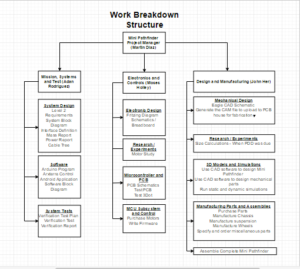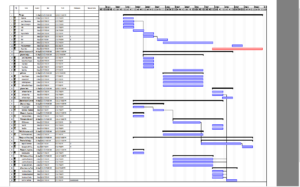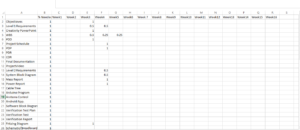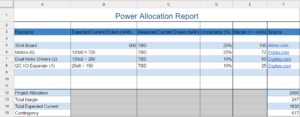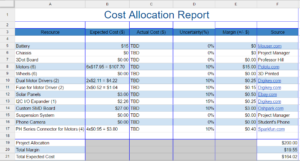Preliminary Project Plan
By Martin Diaz (Project Manager)
Adan Rodriguez (Mission System and Test)
Moses Holley ( Electronics and Control)
John Her (Manufacturing)
Edgardo Villalobos (Solar Manufacturing)
Table of Contents
WBS
By Martin Diaz (PM),
Adan Rodriguez(Mission,Systems)
The work breakdown structure organizes the work needed to complete the project by putting task under each engineer. For our WBS the work of the system engineer was organized into 3 blocks, System Design, Software, and system tests. The work of the ENC engineer was organized into 4 blocks, Electronic Design, Research/Experiments, Microcontroller and PCB, and finally MCU Subsystem and control. The work of the Manufacturing engineer was broken down into 5 blocks, Mechanical Design, Research, 3D simulations, and manufacturing parts and assemblies, and assemble Mini-Pathfinder.
Schedule
By Martin Diaz (PM)
The project schedule was created by using Project Libre. Each Task in the WBS was put as task into Project Libre and then the start and end dates were assigned. When a task depended on a other task to be finished first dependencies were assigned. This can be done by clicking and dragging arrows to other boxes. The program will automatically adjust the task.
Burndown
By Martin Diaz (PM)
The Burndown is a chart that shows how much work is left to complete the project vs time. The Burndown was calculated by moving the task in the schedule to columns in excel and then assigning the percent completion for each task. The ideal percent completion and real percent completion were then plotted vs time.
Power Allocation
By Adan Rodriguez (Mission and Systems)
John Her (Manufacturing)
Moses Holley (ENC)
Edgardo Villalobos (Solar-Manufacturing)
The power rating for all of the components on the Power Allocation Report list were calculated using specification sheets of corresponding components. We approximated our mission duration to be 1 hour (one fourth the duration of the Pathfinder’s mission due to our rover being one fourth scale in size). Using the specification sheets to find current ratings of the components, we multiplied the current ratings by one hour to calculate power ratings in milliamp-hours. For the motor drivers, we looked at the power consumption of the IC and divided the operating voltage to get the current draw (0.78W/6V=130mA). The I2C I/O Expander is rated for output of 25 milliamps per pin and we will be utilizing 6 pins implying a total power consumption of 150 milliamp-hours. The Project Power Allocation was set to be slightly higher than the total Expected Power. Note that the Project’s Power Allocation value was used to aid in determining which battery to choose for our mission.
Mass Allocation
By Adan Rodriguez (Mission and Systems)
John Her (Manufacturing)
Moses Holley (ENC)
Edgardo Villalobos (Solar-Manufacturing)
Estimates of the 3Dot Board and Custom SMD Board were based off the fact that they are similar in size to the Raspberry-Pi Board (31 millimeters x 66 millimeters). The chassis, solar panel and suspension system were weighed with a scale. Corresponding Sources of expected weights is provided under the Source column. The Project Mass Allocation was set to be slightly higher than the total Expected Weight.
Cost Allocation
By Adan Rodriguez (Mission and Systems)
John Her (Manufacturing)
Moses Holley (ENC)
Edgardo Villalobos (Solar-Manufacturing)
The current battery that we intend to buy may be switched out for a different battery after the Mini Pathfinder is built and tested for its power efficiency. About one third of the products that will make up the Mini Pathfinder will be free of charge due to our team members already possessing certain products. Corresponding sources of expected pricing is provided under the Source column. Because the Mini Pathfinder didn’t have a cost requirement the Project Cost Allocation was set to be slightly higher than the total Expected Cost.

